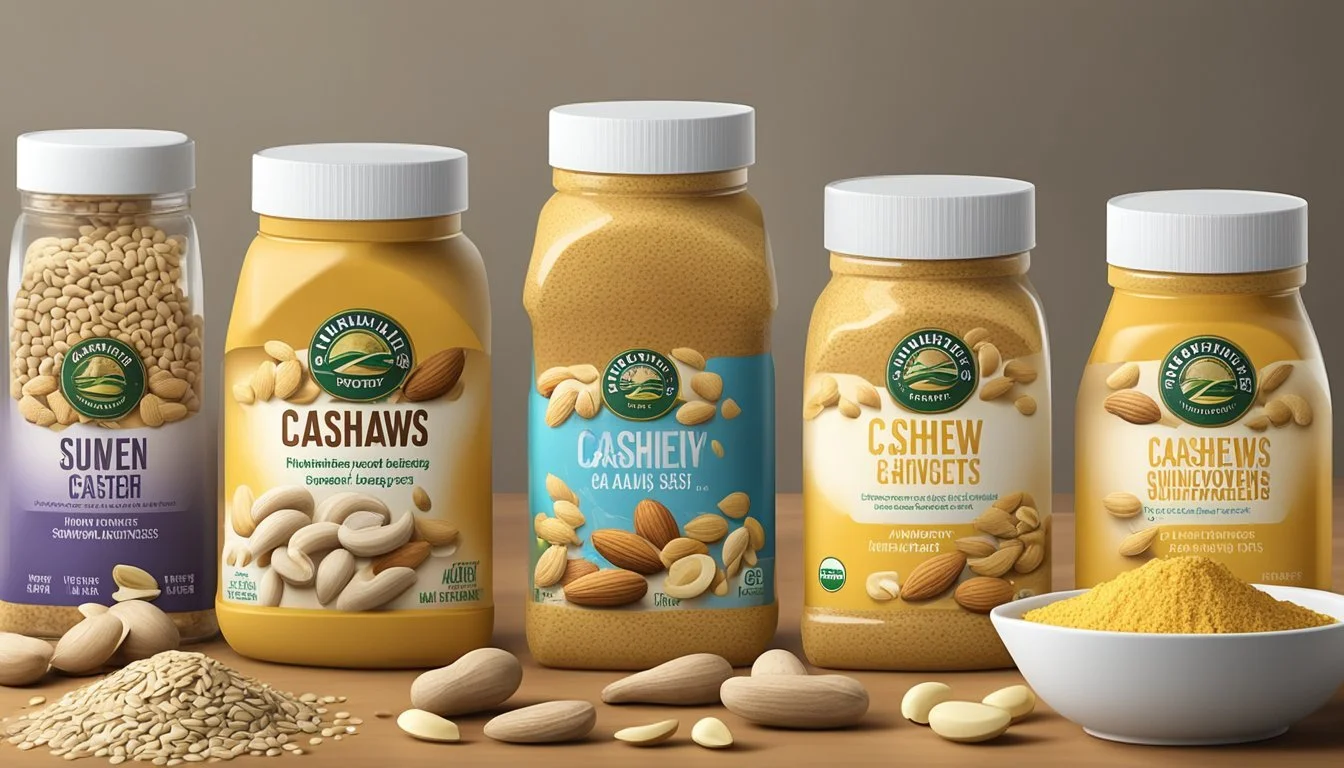Nutritional Yeast Substitutes
Top Alternatives for Your Diet
Nutritional yeast, a staple in vegan cooking, is celebrated for its cheesy, nutty, and umami-rich flavor. Often used to enrich dishes with a depth of flavor and a boost of nutrition, it's a deactivated form of Saccharomyces cerevisiae, a species of yeast. Due to its high content of B vitamins, minerals, and protein, it not only serves as a flavorful addition to meals but also as a nutritional supplement. Despite its numerous benefits, some people may seek alternatives, either due to dietary restrictions, availability issues, or personal taste preferences.
For those looking to replicate the taste and nutritional profile of nutritional yeast, there are several viable substitutes that can be found in most kitchens. Ingredients like brewer's yeast, which comes from the same yeast species, can offer a similar flavor profile and are often recommended as direct replacements in recipes. Other alternatives, such as soy sauce, chickpea flour, and dried mushrooms (What wine goes well with mushrooms?), provide their own unique flavors while still delivering on the umami quality that nutritional yeast is known for. Each substitute carries its own set of benefits and best-use scenarios, allowing for flexibility in various culinary applications.
Understanding Nutritional Yeast
Nutritional yeast is a deactivated yeast known for its health benefits and versatile culinary uses, providing a rich source of B vitamins and a nutty, cheesy flavor to dishes.
Nutritional Profile
Nutritional yeast boasts a significant nutritional profile. It is a rich source of B vitamins, including Vitamin B12, which is essential for nerve function and the production of DNA and red blood cells. Vitamin B12 is particularly notable because it is often supplemented in plant-based diets, as it does not occur naturally in most plant foods.
It also contains all nine essential amino acids, making it a complete protein, which is beneficial for muscle repair and growth. Additionally, nutritional yeast contains glutamate, a naturally occurring compound that provides an umami flavor, enhancing the taste of various dishes.
Packed with vitamins and minerals, this yeast variant provides a range of antioxidants which can help neutralize free radicals and may contribute to improved health. The specific nutritional content can vary by brand, often due to fortification. Below is a typical nutritional table for one serving (2 tablespoons or approximately 15 grams):
Nutrient Amount Calories 60 Protein 8g Fiber 4g Sugars 0g Fat 1g Vitamin B1 (Thiamine) 640% DV Vitamin B2 (Riboflavin) 570% DV Vitamin B3 (Niacin) 280% DV Vitamin B6 480% DV Vitamin B12 130% DV Folate 60% DV
(DV refers to Daily Value based on a 2,000-calorie diet.)
Culinary Uses
Nutritional yeast can be used in a myriad of culinary contexts. It is often utilized for its savory, cheese-like flavor in plant-based cooking, making it a staple in vegan diets. It can be sprinkled over popcorn, stirred into soups, or added to sauces and dressings. Nutritional yeast achieves its distinct taste profile partly due to the presence of glutamate, which contributes to its savory flavor.
Due to its powdery form, it blends well into smooth mixtures and can serve as a thickening agent, enriching the flavors of the base materials in a sauce or spread. It's commonly used in dairy-free cheese recipes, scrambles, and seasoning blends, adding not just taste but also nutrition to every meal. Nutritional yeast's application isn’t limited to savory dishes, as it can even be incorporated into some baked goods and desserts where a depth of flavor is desired.
Primary Nutritional Yeast Substitutes
When seeking an alternative to nutritional yeast, one must consider substitutes that offer a similar cheese-like, umami flavor profile. The following substitutes are the most commonly recommended options, each bringing their unique qualities to various dishes.
Brewer’s Yeast
Brewer’s yeast, a byproduct of brewing beer, shares a species – Saccharomyces cerevisiae – with nutritional yeast, making it a close match in flavor. It imparts a slightly bitter taste and is rich in protein and various B vitamins, though not always B12, which nutritional yeast often has added.
Usage: Substitute in equal parts when cooking, but taste as you go due to the bitterness.
Soy-Based Substitutes
Soy-based products like miso paste and soy sauce are excellent for replicating the savory depth found in nutritional yeast.
Miso Paste: A fermented soybean paste that offers a complex flavor profile.
Utilize miso paste sparingly; it is potent.
Provides rich umami notes suitable for soups, dressings, and marinades.
Soy Sauce: A liquid condiment that enhances dishes with its salty, umami quality.
A half tablespoon can replace a tablespoon of nutritional yeast, especially in stir-fries and sauces.
Remember to adjust the recipe’s salt content accordingly due to soy sauce's inherent salinity.
Cheese Alternatives
For those who are not strictly plant-based, various cheese alternatives can be sprinkled onto dishes for a nutritional yeast-like flavor.
Parmesan: A hard, aged cheese with a nutty and cheesy profile.
Grate and use sparingly for a similar burst of flavor.
For vegans, vegan cheese products are available that mimic the taste and texture of traditional cheeses using plant-based ingredients.
Vegan Cheese: Crafted from various plant sources such as nuts and soy.
Select a brand with a flavor profile that suits the dish in question, as vegan cheeses vary widely in taste and texture.
Vegan and Dietary Substitutes
When pursuing a plant-based or dietary-restricted lifestyle, one often seeks alternatives that offer the same savory qualities as nutritional yeast. These substitutes must be vegan, potentially gluten-free, and available for a variety of kitchen applications, such as vegan parmesan and vegan cheese sauce.
Plant-Based Ingredients
Vegan replacements for nutritional yeast tend to revolve around plant-based ingredients that can replicate the umami and cheesy flavors in vegan recipes. Primary among these are:
Ground flaxseed meal: Provides a nutty flavor and is rich in omega-3 fatty acids.
Cashews: Often blended to make a creamy, dairy-free cheese sauce or vegan parmesan.
Mushrooms: Dried varieties like shiitake or oyster mushrooms can be ground to mimic the savory taste found in nutritional yeast.
Tahini: Made from sesame seeds, it has a rich, nut-like flavor suitable for various dishes.
Gluten-Free Options
Those on gluten-free diets also have alternatives that align with both vegan and vegetarian principles, excluding any animal products. Here are some key examples:
Yeast extracts: Like marmite or Vegemite, suitable for soups and stews. They should be confirmed gluten-free as these products can vary.
Miso paste: Offers a deep umami flavor, though one should ensure it's made with gluten-free grains.
Utilizing these substitutes ensures that dietary preferences are respected without compromising on flavor or texture.
Savory and Umami Flavor Enhancers
In the quest for the perfect blend of savory and umami flavors, especially when substituting nutritional yeast, one may consider a variety of condiments and sauces, as well as select dried mushrooms. These alternatives can provide the depth and complexity that match the cheesy and umami-rich profile nutritional yeast is known for.
Condiments and Sauces
Condiments and sauces are a vital part of replicating the savory and umami essences in dishes. When nutritional yeast is not an option, several alternatives bring out similar flavors:
Soy Sauce: This fundamental ingredient in many Asian cuisines imparts a strong umami taste. For those monitoring sodium intake, low-sodium varieties are available.
Miso Paste: Made from fermented soybeans, this paste adds richness and depth, with white miso being milder and sweeter, suitable for creating a cheesy nuance.
Coco Aminos: As a soy sauce alternative, this slightly sweet sauce provides a similar umami kick with less salt and a unique profile.
For a direct and concentrated flavor punch, one might opt for these sauces in their recipes.
Dried Mushroom Varieties
Dried mushrooms are another esteemed approach to enhancing dishes with umami flavors. Cooking enthusiasts often lean on certain varieties to bolster the savory facets of their creations:
Porcini: Known for their robust flavor, porcini mushrooms can be ground into a powder and used as a seasoning.
Shiitake: Renowned for their meaty texture and rich flavor profile, shiitake mushrooms contribute a notable umami touch when used in recipes.
Chanterelle: With a more subtle taste, these mushrooms add a mild umami flavor perfect for dishes requiring a nuanced enhancement.
When nutritional yeast is out of reach, incorporating these mushrooms, whether as part of roasted veggie dishes or as a seasoning, can elevate a dish's overall flavor complexity.
Textural and Flavor Alternatives
When seeking a nutritional yeast substitute, it's important to consider both the texture and flavor profile. Alternatives should ideally mimic the original product's nutty and cheesy characteristics, often desired for their versatility in vegan cooking.
Nuts and Seeds
Cashews: Ground cashews are a popular choice for their creamy texture and subtle nutty taste. They can be used in sauces and spread to emulate that distinct cheesy flavor.
Flavor & Texture: Mild nuttiness; smooth when blended
Sunflower Seeds: These seeds can be ground and used similarly to cashews, offering a different nutritional profile and flavor twist.
Flavor & Texture: Slightly sweet, nutty; creamy when ground
Legume and Grain Flours
Chickpea Flour: High in protein and fiber, chickpea flour brings a nutty flavor profile and a dense texture to dishes, making it a hearty nutritional yeast substitute.
Flavor & Texture: Nutty, slight bean-like flavor; dense, earthy texture
Yeast Extract: While not a flour, yeast extract shares a similar umami profile to nutritional yeast and can be used in small amounts to impart a savory depth of flavor.
Flavor & Texture: Rich umami; spreadable paste
In conclusion, a variety of nuts, seeds, legumes, and grain flours can serve as suitable substitutes for nutritional yeast, offering both textural satisfaction and complementary flavors to a range of vegan dishes.
Cooking with Substitutes
Cooking with substitutes for nutritional yeast, often referred to as nooch, requires understanding the texture and flavor profile that yeast brings to different dishes. Choosing the right substitute can help maintain the desired taste and consistency.
Substitutes in Sauces and Broths
When it comes to sauces and broths, the savory, cheesy flavor of nooch is a key element. In this context, white miso paste is an excellent substitute, particularly in umami-rich recipes. For one tablespoon of nutritional yeast, use one teaspoon of white miso paste, keeping in mind that miso is saltier.
Brewer's yeast is another suitable replacement for nutritional yeast, especially in vegetable broths or creamy sauces for pasta and rice.
Dish Type Substitution Option Quantity for 1 Tbsp of Nutritional Yeast Creamy Sauces White Miso Paste 1 tsp Vegetable Broths Brewer's Yeast 1 Tbsp
For vegan parmesan cheese, ground cashews mixed with garlic powder, salt, and onion flakes can offer a similarly satisfying topping for salads and soups sans the nooch.
Seasoning Mixes and Coatings
In seasoning mixes and coatings, such as those used for tofu, popcorn, or breadings, the unique taste of nutritional yeast is pivotal for contributing a cheesy and nutty profile.
Coconut aminos provide a sweet and savory flavor comparable to the richness of nooch. They work well in marinades and dressings, offering a slight sweetness and contributing to a succulent caramelization when used in coatings.
Liquid aminos serve as an alternative, imparting a deeply savory character to dishes.
It is recommended to use lesser amounts of liquid aminos or coconut aminos than nutritional yeast due to their strong flavors. For liquid aminos, start with a ratio of about half a tablespoon for each tablespoon of nooch required, and adjust for taste.
Food Type Substitution Option Starting Quantity for 1 Tbsp of Nutritional Yeast Marinades Coconut Aminos Adjust to taste; start small Tofu Coatings Liquid Aminos 1/2 Tbsp
Incorporating these substitutes into one's cooking can help replicate the intended flavors of dishes that traditionally depend on nutritional yeast while accommodating dietary preferences and restrictions.
Substitutes for Special Recipes
When replacing nutritional yeast in recipes, it is important to consider the flavor profile and the role nutritional yeast plays in the dish. The substitutes will vary based on whether the dish is savory or sweet, and different ingredients will provide alternative nutritional benefits and flavors that should complement the overall dish.
Baking and Desserts
In baking and desserts, nutritional yeast is seldom a primary ingredient, but when it is used, its purpose is to introduce a depth of flavor or to enrich the dish's nutritional value. In such cases:
For flavor: Brewer's yeast can serve as a substitute, though it has a stronger, more bitter taste, and should be used sparingly.
For nutritional enhancement: Ground flax seeds may be included to boost the fiber content.
Main Dishes and Sides
Nutritional yeast often plays a key role in the flavor and texture of main dishes and sides, especially in vegan cooking for its cheese-like taste.
For vegan cheese sauce: A blend of cashews and white miso paste can replicate the creamy texture and umami richness.
In pastas and potatoes: A few dashes of soy sauce or coconut aminos can enrich dishes with an umami dimension similar to nutritional yeast.
For beer brewing flavor: Although not a common culinary ingredient, Brewer's yeast is similar to nutritional yeast and can introduce a comparable taste profile in recipes rooted in beer brewing techniques.
Health Considerations of Substitutes
When considering substitutes for nutritional yeast, it is important to analyze their nutritional content and potential allergens or intolerances to ensure they align with dietary needs and restrictions.
Nutritional Content
Protein: Many nutritional yeast substitutes lack the high protein content that nutritional yeast offers. For instance, while brewer's yeast is a comparable substitute in terms of protein, alternatives like soy sauce have negligible protein content.
Vitamins & Minerals: Substitutes vary in their vitamin and mineral profiles. Brewer's yeast can provide B vitamins, but may not have the fortified vitamin B12 that nutritional yeast often contains. Choices like cashews offer healthy fats and minerals, but are not a significant source of B12 or other vitamins.
Fiber: Nutritional yeast is a good source of dietary fiber. Substitutes like barley may offer comparable levels of fiber, yet others may fall short in this aspect.
Allergens and Intolerances
Gluten: Barley, a potential substitute, contains gluten, making it unsuitable for those with celiac disease or gluten sensitivities.
Yeast Allergy: Those with yeast allergies should avoid brewer's yeast as it is from the same species, Saccharomyces cerevisiae.
Dairy Sensitivities: Substitutes like ricotta or whey are derived from dairy and not suitable for those with lactose intolerance or a dairy allergy.
Sodium Content: Saltiness is an attribute of nutritional yeast, and substitutes like soy sauce are high in sodium, which could be a concern for those monitoring their salt intake.





